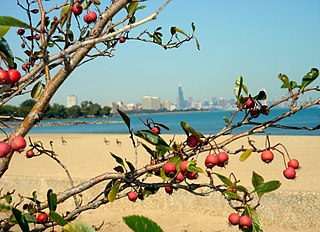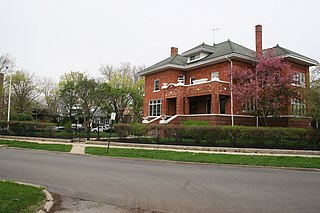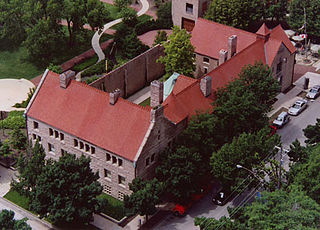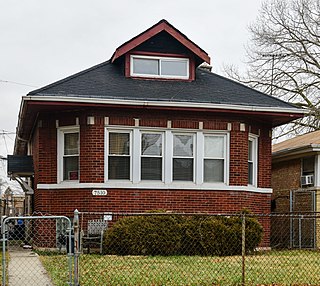
Streeterville is a neighborhood in the Near North Side community area of Chicago, Illinois, United States, north of the Chicago River. It is bounded by the river on the south, the Magnificent Mile portion of Michigan Avenue on the west, and Lake Michigan on the north and east, according to most sources, although the City of Chicago only recognizes a small portion of this region as Streeterville. Thus, it can be described as the Magnificent Mile plus all land east of it. The tourist attraction of Navy Pier extends out into the lake from southern Streeterville. The majority of the land in this neighborhood is reclaimed sandbar.

South Shore is one of 77 defined community areas of Chicago, Illinois, United States. A predominantly African-American neighborhood on the city's South Side, the area is named for its location along the city's southern lakefront. Although South Shore has seen a greater than 40% decrease in residents since Chicago's population peaked in the 1950s, the area remains one of the most densely populated neighborhoods on the South Side. The community benefits from its location along the waterfront, its accessibility to Lake Shore Drive, and its proximity to major institutions and attractions such as the University of Chicago, the Museum of Science and Industry, and Jackson Park.

The Near South Side is a community area of Chicago, Illinois, United States, just south of the downtown central business district, the Loop. The Near South Side's boundaries are as follows: North—Roosevelt Road ; South—26th Street; West—Chicago River between Roosevelt and 18th Street, Clark Street between 18th Street and Cermak Road, Federal between Cermak Road and the Stevenson Expressway just south of 25th Street, and Clark Street again between the Stevenson and 26th Street; and East—Lake Michigan.

West Ridge is one of 77 Chicago community areas. It is a middle-class neighborhood located on the far North Side of the City of Chicago. It is located in the 50th Ward and the 40th Ward. Also historically called North Town, and frequently referred to as West Rogers Park, it is bordered on the north by Howard Street, on the east by Ridge Boulevard, Western Avenue, and Ravenswood Avenue, the south by Bryn Mawr Avenue and Peterson Avenue, and on the west by Kedzie Avenue and the North Shore channel of the Chicago River. At one time joined with neighboring Rogers Park, it seceded to become its own village in 1890 over a conflict concerning park districts. West Ridge was annexed to Chicago on April 4, 1893, along with Rogers Park.

Chatham is one of the 77 community areas of the city of Chicago, Illinois. It is located on the city's South Side. It includes the neighborhoods of Chatham-Avalon, Chatham Club, Chesterfield, East Chatham, West Chatham and the northern portion of West Chesterfield. Its residents are predominantly African American, and it is home to former Senator Roland Burris. Housing many city employees and other officials, Chatham has been a central area for Chicago's middle-class African Americans since the late 1950s.

The Medbury's–Grove Lawn Subdivisions Historic District is a residential historic district located in Highland Park, Michigan. It runs along three east–west streets: Eason Street, Moss Street, and Putitan Street, from Hamilton Avenue on the west to Woodward Avenue on the east. The district was listed on the National Register of Historic Places in 1988.

Glenview Historic District is a neighborhood in Memphis, Tennessee that was listed on the National Register of Historic Places as a historic district in 1999. The neighborhood is between South Memphis and Midtown and bounded by the Illinois Central Railroad on the west, Lamar Ave on the east, Southern Ave on the north and South Parkway on the south.

The Ravenswood Manor Historic District is a historic district in the Albany Park community area of North Side, Chicago, Illinois. It is bordered by the Chicago River on the East, and by the alley south of Lawrence Avenue on the North, Sacramento Avenue on the West, and the alley North of Montrose Avenue on the south.

Prairie Avenue is a north–south street on the South Side of Chicago, which historically extended from 16th Street in the Near South Side to the city's southern limits and beyond. The street has a rich history from its origins as a major trail for horseback riders and carriages. During the last three decades of the 19th century, a six-block section of the street served as the residence of many of Chicago's elite families and an additional four-block section was also known for grand homes. The upper six-block section includes part of the historic Prairie Avenue District, which was declared a Chicago Landmark and added to the National Register of Historic Places.

The South Park Manor Historic District is a residential historic district in the Greater Grand Crossing neighborhood of Chicago, Illinois. The district includes 263 Chicago bungalows built between 1915 and 1927. At the time, single-family homeownership was becoming broadly accessible to Chicagoans, and the bungalow was a popular choice for dense urban housing. The bungalows in the district were designed by several developers, but the district has a consistent appearance nonetheless. The use of a single home type throughout provided uniformity to the neighborhood, while stylistic variations such as the placement of dormers and porches gave each house its own character. The developers also gave their homes spacious lawns and private backyards to preserve green space in an urban setting.

The West Chatham Bungalow Historic District is a residential historic district in the Chatham neighborhood of Chicago, Illinois. The district includes 283 Chicago bungalows built between 1913 and 1930 along with a smaller number of other residential buildings. As Chicago grew in the early 20th century and homeownership became more accessible, the bungalow arose as a popular and affordable house design, and tens of thousands of them were built in the city. Chatham, an outlying neighborhood on the city's South Side, benefited from this housing boom, as its transit connections made the area an attractive choice for new housing. The West Chatham bungalows are all brick and feature similar designs, giving the neighborhood a uniform appearance; however, decorative features such as patterned brickwork provide diversity among the homes.

The Auburn Gresham Bungalow Historic District is a residential historic district in the Auburn Gresham neighborhood of Chicago, Illinois. The district includes 264 Chicago bungalows built from 1918 to 1932 along with a variety of other residential buildings. Homeownership became more attainable for working-class Chicagoans in the early twentieth century, and affordable bungalows played a key role in this pattern, with tens of thousands of the homes built in the city. Auburn Gresham, a South Side neighborhood with railroad access and little prior development, was one of the many parts of the city developed during the bungalow boom. While thirty-two different architects designed homes in the district, the bungalows are still relatively similar, as the uniform building design was a major factor in their affordability; however, elements such as color and brickwork distinguish the individual homes.

The Brainerd Bungalow Historic District is a residential historic district in the Brainerd neighborhood of the Washington Heights community area of Chicago, Illinois. The district includes 527 Chicago bungalows built between 1915 and 1931 and a small number of other residential buildings. Brainerd, an outlying neighborhood of Chicago, was developed in the 1910s and 1920s as the increasing accessibility of homeownership spurred new home construction in underpopulated areas of the city. As bungalows were affordable to construct, they became popular in newly developed neighborhoods, and tens of thousands of them were built throughout the city. While 42 different architects designed Brainerd's bungalows, the neighborhood has a consistent appearance nonetheless, as the affordability of bungalows came in part from how easy the design was to duplicate; however, architects used color and detail work to give each home a unique design.

The Schorsch Irving Park Gardens Historic District is a residential historic district in the Dunning neighborhood of Chicago, Illinois. The district includes 255 buildings, all but three of which are Chicago bungalows. In the early twentieth century, tens of thousands of Chicago bungalows were built in the city; as homeownership became more accessible to working-class Chicagoans, demand for housing increased, and bungalows were an affordable way of meeting this demand due to their relatively uniform design. The bungalows in the district were largely built either between 1917 and 1918 or between 1922 and 1926. Unlike Chicago's other bungalow-dominated neighborhoods, which often had several different developers, developer Albert J. Schorsch built every bungalow in the district, and architech Ernest N. Braucher designed all of them. To add diversity to a neighborhood made up of only one style of house, the two men varied the homes' roof shapes, colors, and dormers.

The Wrightwood Bungalow Historic District is a residential historic district encompassing the 4600 and 4700 blocks of Wrightwood Avenue in the Belmont Cragin neighborhood of Chicago, Illinois. The district includes 58 houses built between 1916 and 1926, 55 of which are Chicago bungalows. As homeownership became more accessible in early twentieth century Chicago, the bungalow became popular as an affordable home design, and tens of thousands of the houses were built throughout Chicago. Like many of Chicago's bungalow-heavy neighborhoods, both the district and the Belmont Cragin neighborhood in general saw little residential development before the bungalow boom; however, the area was much more industrial than most similar neighborhoods. While several developers built bungalows in the district, the Stolzner Construction Company built over half of them, including every bungalow on the 4600 block. The company's architect, Joseph Klafter, differentiated the bungalows by changing details such as their color, entrance position, and dormer design.

The Rogers Park Manor Bungalow Historic District is a residential historic district in the West Ridge neighborhood of Chicago, Illinois. The district includes 329 buildings, 247 of which are Chicago bungalows built in the 1920s. As homeownership became more accessible to working-class Chicagoans in the early twentieth century, bungalows became an affordable and popular style due to their easily replicable design, and tens of thousands of the houses were built throughout Chicago. The Rogers Park Manor area was typical of new bungalow neighborhoods, as it was an underdeveloped outlying neighborhood near the city's northern edge. The bungalows in Rogers Park Manor were built by several different developers and architects, which led to variation in the size and shape of the homes despite their similar designs.

The Falconer Bungalow Historic District is a residential historic district in the Belmont Cragin neighborhood of Chicago, Illinois. The district comprises 348 Chicago bungalows built from 1915 to 1931. As homeownership became more affordable in early twentieth century Chicago, the bungalow became popular as an affordable and easily replicable home style, and tens of thousands of the homes were built throughout the city. While more industrial than average, the Belmont Cragin area was otherwise typical of the new bungalow neighborhoods, as it was an underdeveloped area on the outskirts of the city. Laughlin Falconer, for whom the district is named, owned and farmed on the land before dividing it and selling it to developers in 1913. Architects Ernest Braucher and Johan F. Knudson designed most of the bungalows in the district; both architects frequently gave their houses full-length, open-air front porches, and the district has one of the city's most significant collections of open front porch bungalows as a result.

The Talman West Ridge Bungalow Historic District is a residential historic district in the West Ridge neighborhood of Chicago, Illinois. 181 of the district's 272 buildings are either brick Chicago bungalows or older stucco bungalows built from 1919 to 1930. As homeownership became more affordable in early twentieth century Chicago, the bungalow became popular for its easily and cheaply replicated design, and tens of thousands of the homes were built throughout the city. West Ridge, a lightly developed area on Chicago's northern border, was typical of the neighborhoods that were dominated by new bungalows. While a variety of developers and architects built the district's bungalows in distinctive fashions, the homes' similar designs and consistent setbacks from the street give the district a cohesive appearance.

The Portage Park Bungalow Historic District is a residential historic district in the Portage Park neighborhood of Chicago, Illinois. The district includes 225 buildings, 189 of which are brick Chicago bungalows built between 1915 and 1930. As homeownership became broadly accessible to Chicagoans in the early twentieth century, the bungalow emerged as a popular and affordable house design, and tens of thousands of the homes were built throughout Chicago. Portage Park was one of the many outlying neighborhoods of Chicago which grew dramatically as a result of the housing boom; new residents were also attracted to the neighborhood's eponymous park. While the district was developed by many different builders and architects, the use of a single home type with uniform setbacks from the street gives the neighborhood a consistent appearance.
The Gage Park Bungalow Historic District is a residential historic district in the Gage Park neighborhood of Chicago, Illinois. The district includes 465 Chicago bungalows and eighteen other residential buildings. The bungalows were built between 1919 and 1931, a time in which single-family homeownership became broadly accessible in Chicago; as bungalows could be mass-built affordably, they appealed to these new homeowners. Gage Park, an underbuilt neighborhood in southwest Chicago, was one of the many outlying areas of the city in which large numbers of new bungalows were built in the early twentieth century. While the bungalows have a consistent shape and are set back evenly from the street, giving the district a uniform appearance, variations in color, brick patterns, and roof forms differentiate the individual houses.





















